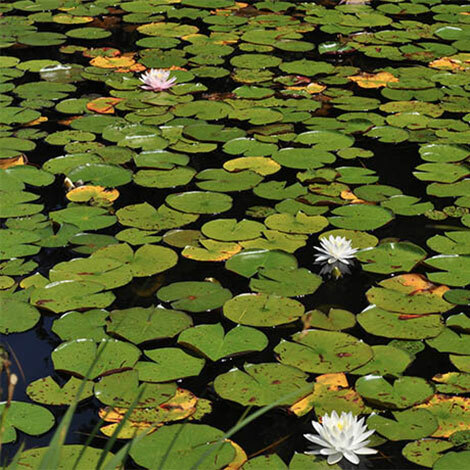A: It’s a common question amongst backyard pond owners—how do you kill lily pads without harming fish? For all of their charm, lily pads can be a real nuisance. And while there certainly are many tutorials out there on how to get rid of lily pads in a pond, not all methods are effective.
The problem is lily pads use both seeds and expansive underwater root systems to reproduce. This lily pad root system is not easy to remove manually, nor is it realistic to pick up every seed. This leaves herbicidal treatment as the most effective option.
However, those worried about their pond fish may be hesitant to try chemical solutions. Many pond owners are left wondering how to kill lily pads in a pond while keeping their fish safe.
Is Killing Lily Pads the Best Way to Get Rid of Them?
To truly remove all lily pads from your pond, it is often necessary to kill them. While mechanical options do exist, these methods tend to fall short. You may have noticed that lily pads are found in clusters, and those clusters spread fast. Water lily seeds blow to other areas of the pond and expand the infestation. Meanwhile, the underwater rhizomes sprout new growth within each cluster.
This all boils down to the fact that getting rid of water lilies is challenging without introducing some herbicide.
What Kills Lily Pads?
Many herbicides are harmful to lily pads. The key is finding the one that is best for your pond. Three types of chemicals to try are:
- Season-long herbicides, such as Airmax WipeOut Aquatic Herbicide
- Broad-spectrum herbicides, such as Airmax Ultra PondWeed Defense
- Systemic herbicides, such as Airmax Shoreline Defense Emergent Weed Control
Season-long herbicides are applied in the spring and provide protection all year long—you can use them proactively before an infestation occurs. You may need multiple applications of a systemic or broad-spectrum herbicide, but they can be effective later in the season against existing water lily populations.
How Do You Kill Lily Pads Without Harming Fish?
The good news is most aquatic herbicides are considered safe for pond fish. The EPA categorizes the active ingredients in many popular herbicides as either practically non-toxic or low in toxicity to fish.
It’s important to keep in mind, though, that lily pads exist in nature for a reason. They provide shade, oxygen, and shelter. Fish need these things to survive. One risk of herbicides is that they can alter a fish’s natural environment too much, making a pond a less hospitable place to live. Try to ensure that your pond still has a good balance of non-invasive plants and shade available for its resident fish.
Will Vinegar Kill Lily Pads?
Another common question is how to get rid of lily pads in a lake naturally. Vinegar is one often suggested solution.
It is true that vinegar isn’t great for lily pads. It can cause the pads to dry up and inhibit new growth. If you’ve caught the very beginning of a lily pad infestation, a few applications of vinegar might be effective. For larger infestations, however, you can skip the vinegar.
How to Eliminate Lily Pads Mechanically
If you are wondering how to get rid of lily pads mechanically, the method is much like you might expect. You can rake the surface of your pond and attempt to physically remove all the lily pads from the water.
A rake will likely not be able to pick up each and every rhizome and seed. If you opt to go the mechanical route, you will need to regularly rake your pond to remove any new growth. This may be feasible for those with smaller ponds, but it’s generally not a sustainable solution for larger ponds and lakes.
Fish-safe herbicides are truly the best method for permanent lily pad removal. If you still have questions about removing lily pads without harming fish, the experts at The Pond Guy are ready to help.
Read More Articles
How to Get Rid of Lake Weeds and Muck
Identify Water Lilies & How to Control Them
Benefits of Aquatic Plants in a Water Garden
Water Lilies With No Flowers
Last Updated: February 27, 2024

